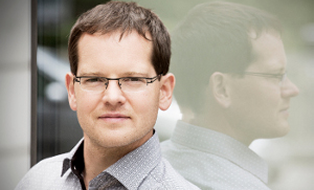Professor in Charge
 © Prof. Dr.-Ing. habil. Christian Mayr
© Prof. Dr.-Ing. habil. Christian Mayr
Mr Prof. Dr.-Ing. habil. Christian Georg Mayr
Send encrypted email via the SecureMail portal (for TUD external users only).
To give a short bio, Christian Mayr received the Dipl.-Ing. (M.Sc.) in Electrical Engineering in 2003, his PhD in 2008 and Habilitation (University teaching qualification) in 2012, all three from Technische Universität Dresden, Germany. From 2003 to 2013, he has been with the Chair of Highly-Parallel VLSI-Systems and Neuro-Microelectronics at Technische Universität Dresden, with a secondment to Infineon AG Munich (2004-2006). From 2013 to 2015, he was working as researcher at Institute of Neuroinformatics, University of Zurich and ETH Zurich, Switzerland. Since 2015 he holds the Chair of Highly-Parallel VLSI-Systems and Neuromorphic Circuits.
His research interests include bio-inspired circuits, biologically-inspired Artificial Intelligence, Brain-Machine-Interfaces, AD converters, pixel sensors and general mixed-signal VLSI-design. His scientific credits include the world-first neuromorphic system-on-chip (SoC) in 28 nm CMOS, several novel mixed-signal ICs aimed at the interface between nerve cell tissue and electronics, as well as foundational work on the modelling and circuit implementation of synaptic plasticity (i.e. learning). He is author or co-author of over 70 publications and holds 3 patents. His work has received the Heinrich Barkhausen Price (2008) by the Carl Friedrich von Siemens Foundation and the Meyer Struckmann Science Price (2013) by the Meyer Struckmann Foundation.
At the Chair of Highly-Parallel VLSI-Systems and Neuromorphic Circuits, Prof. Mayr will continue the sucessful work on neuromorphic circuits carried out in the EU flagship Human Brain Project. Specifically, in the Human Brain Project, the chair teamed up with the University of Manchester to develop the second generation of the SpiNNaker platform for brain simulation and artificial intelligence.
Beyond that, he aims to combine the current scientific areas of the chair to design SoCs that encompass both conventional processor elements and neurally inspired processing in conventional CMOS or nanoscale substrates. These SoCs will exploit synergies between digital and neural paradigms, exhibiting brain-like computational capabilities such as multi-channel sensor fusion, voice and image recognition and decision making in a power-efficient, compact SoC package.
One specific application area targeted by the above SoCs would be neuroprostheses or Brain-Machine-Interfaces. A compact, low-power single-chip solution for e.g. an arm prosthesis, requires an IC that is low-power, integrates a large number of mixed signal biosensors for high-dimensional tissue interfacing and that can do neurally-inspired sensor fusion and processing on the resulting large input space. Digital processing capability is required in the same chip for conventional postprocessing and interfacing to the prosthesis.
Another application area to be pursued by these synergistic SoCs is neuromorphic processing of data streams in mobile devices. A smartphone has access to multiple sensors (e.g. video, acceleration, audio) and needs to process these in a human-like way for e.g. voice analysis, image recognition, sensor fusion, etc. This processing capability should be extremely energy efficient for a mobile application and be available as part of a conventional MPSoC to aid overall high-density system integration.
Based on this combination of high-density, energy-efficient processing as well as on in-house sensor/actor interfaces, the chair will develop the Body Computing Hub (BCH) in the German excellency cluster CeTI. On a hardware level, the BCH will be the main enabler for "Tactile Internet with Humans in the Loop", i.e. the BCH will be distributed multiple times across the human and robotic agents. The BCH will carry out the most of the data processing, sensor interfacing as well as closing the sensor-actor-loop inside the tactile millisecond time frame.
Taking these next steps into the above high-impact, cutting edge research directions would not have been possible without the dedication and effort invested by his predecessor, Prof. Schüffny. All members of the chair wish to express their sincere thanks for the ground-laying work he has done during his tenure.
